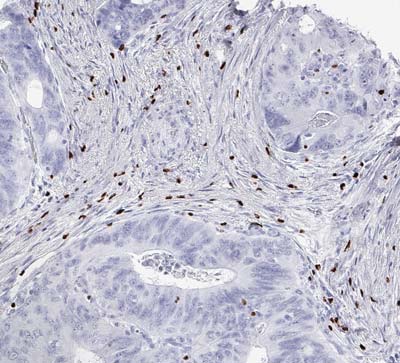Anti-FOXP3 (Hu) from Mouse (FX3) – unconj.
-and-CD112R-(green),-magnification-4x.jpg)
-and-CD112R-(green),-magnification-40x.jpg)

.jpg)
.jpg)
.jpg)
.jpg)
.jpg)
-
Overview
SKU DIA-FX3 Specificity Species Reactivity Immunogen Host Species Isotype Clone Clonality (Mono-/Polyclonal) Application Immunohistochemistry (IHC), Immunohistochemistry (Paraffin-embedded Sections), Western Blot
Conjugation Dilution Format 0.05% NaN3, 2% BSA, in PBS (pH 7.4), lyophilisate, purified antibody (from culture supernatant)
Product line / Topic Intended Use Temperature - Storage Temperature - Transport Search Code Manufacturer / Brand Uniprot_ID Gene_ID Alias AIID, DIETER, Enteropathy, Forkhead Box Protein P3, FOX-P3, FOXP3, Immune Dysregulation, IPEX, JM2, PIDX, Polyendocrinopathy, SCURFIN, X-Linked, XPID
- Datasheets and Downloads
-
Additional Product Information
Anti-FOXP3 antibody clone FX3 validated for fluorescence multiplex immunohistochemistry
Clone FX3 has been developed for the detection of FOXP3 in routine formalin-fixed paraffin-embedded tissue specimen (IHC FFPE) and moreover, it has been validated for fluorescence multiplex IHC studies of FOXP3 expression in human tissues.
FOXP3 (Forkhead box protein P3) is mainly expressed in Regulatory T (Treg) cells. Treg cells are a subset of CD4+ T-cells and play a suppressive role in the immune system. Treg cells ensure immune homeostasis through their ability to suppress the activation and function of leukocytes. Therefore, FOXP3 has emerged as a prominent target for the development of new immunotherapies for cancer and autoimmune diseases.
The transcription factor FOXP3 acts either as a transcriptional repressor or as a transcriptional activator depending on its interactions with other transcription factors, histone acetylases and deacetylases. FOXP3 is important for the development and inhibitory function of regulatory T-cells (Treg) and coordinates the suppressive activity of Treg cells by activation of different genes, e.g. CTLA4 and TNFRSF18 and by repression of genes encoding cytokines such as interleukin-2 (IL2) and interferon-gamma (IFNG).
-
Images
-and-CD112R-(green),-magnification-4x.jpg)
Fig. 01: Multicolor Immunofluorescence of FOXP3 (red) and CD112R (green), magnification 4x, normal tonsil. -and-CD112R-(green),-magnification-40x.jpg)
Fig. 02: Multicolor Immunofluorescence of FOXP3 (red) and CD112R (green), magnification 40x, normal tonsil. 
Fig. 03: FOXP3 positive regulatory T-cells in the Stroma of a colorectal adenocarcinoma. .jpg)
Fig. 04: FOXP3 positive TILs in a high grade serous Ovarian carcinoma. .jpg)
Fig. 05: Focal accumulation of FOXP3 positive TILs in a solid cancer. .jpg)
Fig. 06: Scattered FOXP3 positive TILs in an adenocarcinoma of the stomach. .jpg)
Fig. 07: Higher magnification of the same cancer as in Figure 6. Note the optimal signal to noise ratio of immunostaining. .jpg)
Fig. 08: Normal distribution of FOXP3 positive cells in a tonsil.
